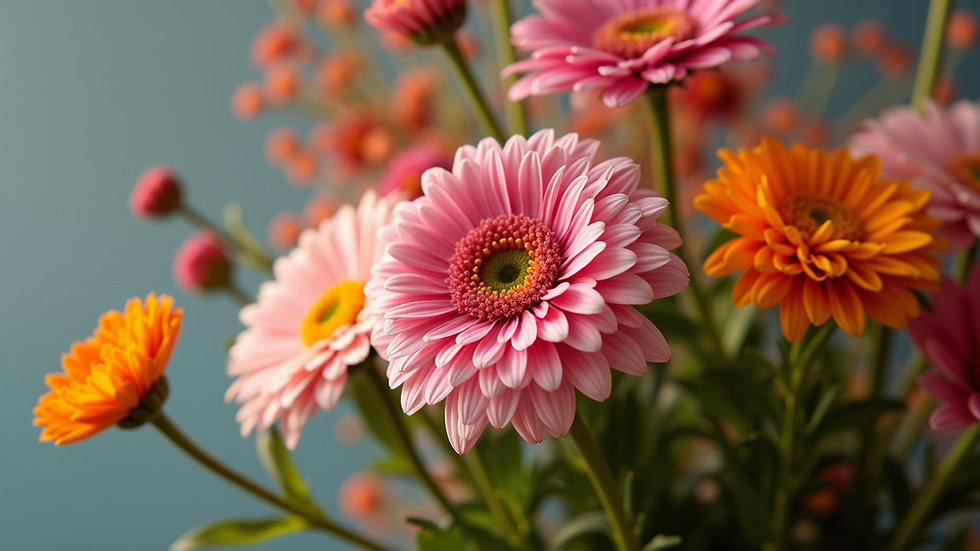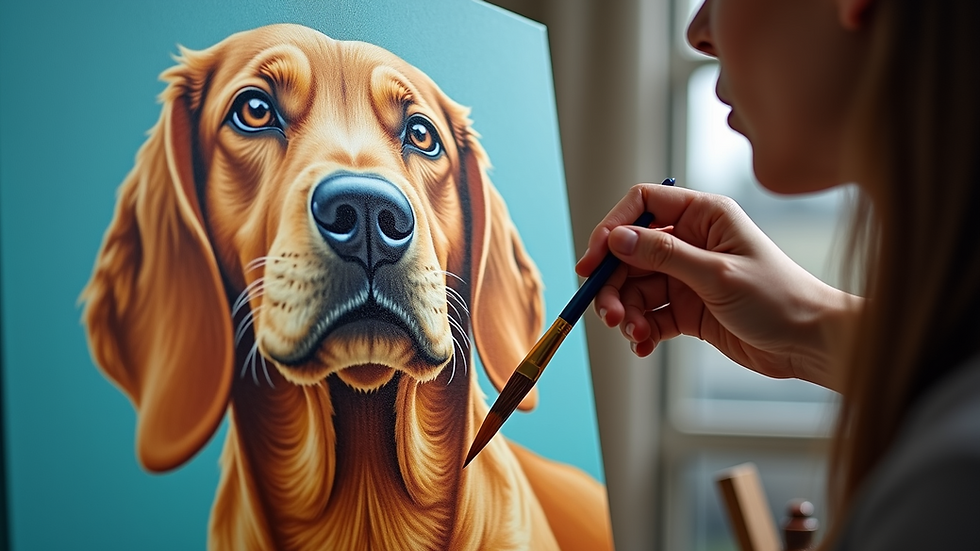Floral Inspiration: Designing Stunning Arrangements and Paintings
- viktoriyabanul
- Aug 19
- 5 min read
Flowers have a unique ability to brighten our days and lift our spirits. Their colors, shapes, and fragrances inspire creativity in many forms. Whether you are a seasoned florist, an aspiring painter, or simply someone who loves flowers, this post will guide you through the art of designing stunning floral arrangements and paintings.
In this blog post, we will explore various techniques, tips, and ideas to help you create beautiful floral designs and artwork. From selecting the right flowers to understanding color theory, we will cover everything you need to know to bring your floral visions to life.
The Beauty of Floral Arrangements
Floral arrangements are more than just a collection of flowers. They are a form of art that can convey emotions and tell stories. When designing a floral arrangement, consider the following elements:
Balance: A well-balanced arrangement feels harmonious. Use flowers of varying heights and sizes to create visual interest.
Focal Point: Every arrangement needs a focal point. This could be a large bloom or an interesting texture that draws the eye.
Color Harmony: Choose colors that complement each other. You can use a monochromatic scheme for a sophisticated look or a contrasting palette for a vibrant feel.
Texture: Incorporate different textures to add depth. Mix smooth petals with rough foliage for a dynamic arrangement.
By keeping these elements in mind, you can create arrangements that are not only beautiful but also meaningful.
Selecting the Right Flowers
Choosing the right flowers is crucial for any arrangement. Here are some tips to help you select the best blooms:
Seasonality: Use flowers that are in season. They will be fresher, more vibrant, and often more affordable.
Local Sourcing: Whenever possible, buy from local florists or farmers. This supports your community and ensures you get the freshest flowers.
Personal Preference: Choose flowers that resonate with you. If you love sunflowers, incorporate them into your designs, even if they are not traditionally used.
Symbolism: Consider the meanings behind different flowers. For example, roses symbolize love, while lilies represent purity. Use this symbolism to enhance your arrangements.
By thoughtfully selecting your flowers, you can create arrangements that reflect your personality and intentions.
Techniques for Stunning Arrangements
Once you have your flowers, it’s time to start arranging. Here are some techniques to help you create stunning floral designs:
Spiral Technique: This method involves placing flowers in a spiral pattern, which creates a natural look. Start with the focal flower and build around it, gradually adding smaller blooms.
Cluster Arrangement: Group flowers in clusters for a bold statement. This technique works well with larger blooms and creates a lush, full appearance.
Line Design: Use tall, linear flowers to create height and drama. This technique is great for modern arrangements and can be very striking.
Asymmetrical Design: Break the rules of symmetry for a more organic feel. This style allows for creativity and can result in unique arrangements.
Experiment with these techniques to find your own style. Remember, there are no strict rules in floral design, so let your creativity flow.
Painting Floral Inspirations
If you are more inclined towards painting, flowers can serve as a beautiful subject. Here are some tips for capturing their essence on canvas:
Observation: Spend time observing flowers in their natural habitat. Notice the way light interacts with their petals and the subtle variations in color.
Sketching: Start with quick sketches to capture the shapes and forms of the flowers. This will help you understand their structure before you begin painting.
Color Mixing: Experiment with mixing colors to achieve the perfect shades. Flowers often have complex colors that require blending to replicate accurately.
Brush Techniques: Use different brush techniques to create texture. A dry brush can mimic the softness of petals, while a fan brush can create the look of foliage.
By practicing these techniques, you can develop your own style and create stunning floral paintings.
Color Theory in Floral Design
Understanding color theory is essential for both floral arrangements and paintings. Here are some key concepts to consider:
Color Wheel: Familiarize yourself with the color wheel. It shows how colors relate to each other and can help you create harmonious palettes.
Complementary Colors: These are colors that are opposite each other on the color wheel. Using complementary colors can create vibrant and eye-catching arrangements.
Analogous Colors: These are colors that are next to each other on the wheel. They create a more subtle and cohesive look.
Warm and Cool Colors: Warm colors (reds, oranges, yellows) evoke energy and excitement, while cool colors (blues, greens, purples) create calm and tranquility. Use these to set the mood of your arrangement or painting.
By applying color theory, you can enhance the visual impact of your floral designs.
Creating a Floral Mood Board
A mood board is a great way to gather inspiration and visualize your ideas. Here’s how to create one:
Collect Images: Gather images of flowers, arrangements, and paintings that inspire you. You can find these in magazines, online, or even take your own photos.
Choose a Theme: Decide on a theme for your mood board. This could be based on a color palette, a season, or a specific emotion.
Arrange Your Board: Lay out your images in a way that feels balanced and visually appealing. You can use physical boards or digital tools like Pinterest.
Add Textures and Materials: Include fabric swatches, paper samples, or other materials that resonate with your theme. This adds depth to your board.
Review and Reflect: Take a step back and review your mood board. Does it capture the essence of what you want to create? Make adjustments as needed.
Creating a mood board can help clarify your vision and guide your floral designs.
Practical Tips for Floral Arranging
Here are some practical tips to keep in mind when arranging flowers:
Use Clean Tools: Always use clean scissors or shears to cut your flowers. This prevents bacteria from entering the stems and prolongs their life.
Water Quality: Use fresh, clean water in your vases. Change the water every few days to keep your flowers looking their best.
Remove Leaves: Strip any leaves that will be submerged in water. This prevents rot and keeps the water clean.
Experiment with Containers: Don’t be afraid to use unconventional containers for your arrangements. Jars, teacups, or even wooden boxes can add character.
Practice Patience: Floral arranging is an art that takes time to master. Don’t rush the process, and allow yourself to experiment and learn.
By following these tips, you can create beautiful arrangements that last longer and look stunning.
The Joy of Gifting Floral Arrangements
Floral arrangements make wonderful gifts for any occasion. Here are some ideas for gifting flowers:
Personalized Bouquets: Create a bouquet that reflects the recipient’s favorite colors or flowers. This shows thoughtfulness and care.
Seasonal Arrangements: Gift arrangements that celebrate the season. Spring flowers, summer blooms, autumn foliage, and winter evergreens all have their charm.
Themed Arrangements: Consider creating arrangements based on themes, such as a beach-inspired bouquet with soft blues and whites or a rustic arrangement with wildflowers.
Accompanying Notes: Include a handwritten note with your arrangement. Share a personal message or a memory associated with the flowers.
Gifting flowers is a beautiful way to express love, gratitude, or sympathy.
Bringing It All Together
Creating stunning floral arrangements and paintings is a rewarding journey. By understanding the principles of design, color theory, and the techniques involved, you can express your creativity in beautiful ways.
Whether you are arranging flowers for a special occasion or painting a still life, let your passion for flowers shine through. Remember to enjoy the process and embrace your unique style.
As you explore the world of floral design and painting, you will discover endless possibilities. So gather your flowers, pick up your brushes, and let your creativity bloom.



Comments